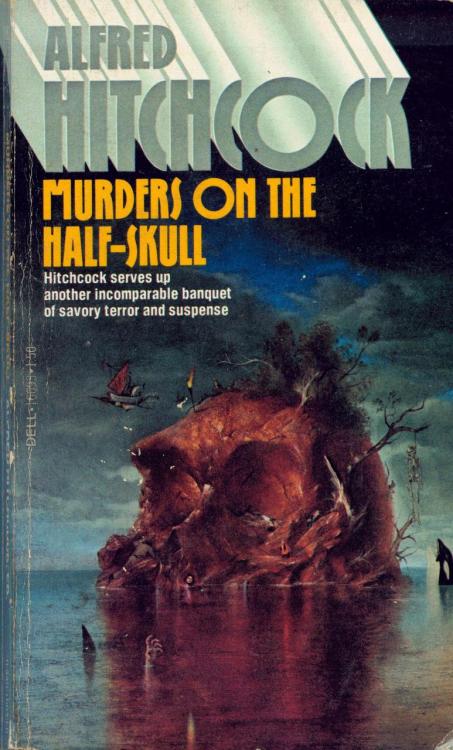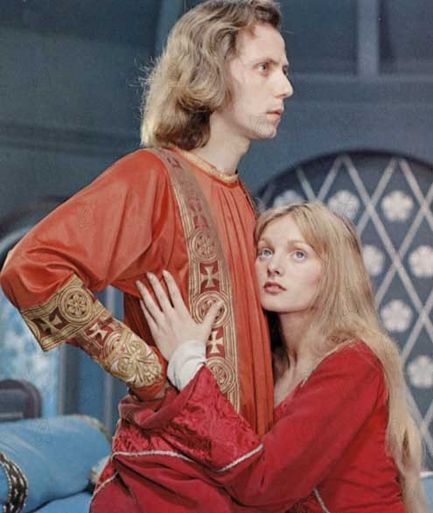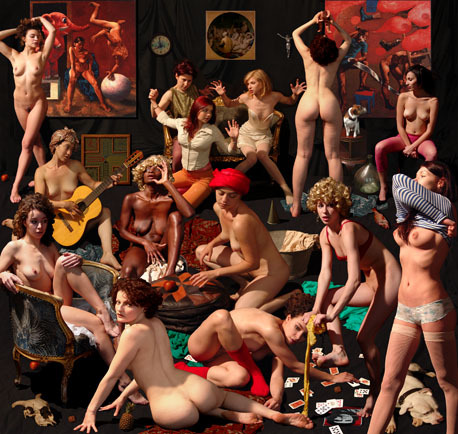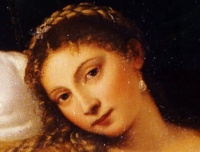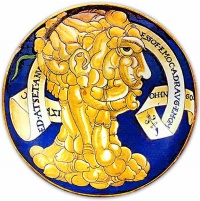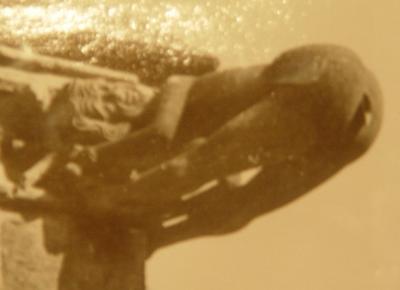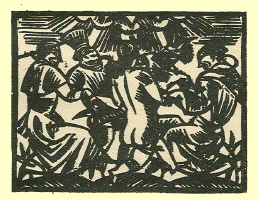Never mind the bollocks, here’s Rabelais

As I noted in a previous post[1] on satirical pornography or pornographic satire, Rabelais‘s masterpiece Gargantua and Pantagruel is more emetic than erotic.
There is however a strain of eroticism to be found in Rabelais, a strain of the bawdy, ribald and burlesque variety, which dates back at its earliest to the Ancient Greek Milesian tale.
The Milesian tales are the earliest instances of erotic literature in the Western world. They directly influenced Apuleius‘ The Golden Ass, Petronius‘ Satyricon in antiquity. They were mentioned in Traitté de l’origine des romans. Aristidean saucy and disreputable heroes and spicy, fast-paced anecdote resurfaced in the medieval fabliaux. Chaucer‘s The Miller’s Tale is in Aristides’ tradition, as are some of the saltier tales in Boccaccio‘s Decameron or the Heptameron of Marguerite of Navarre and the later genre of the picaresque novel.
Googling for “buttocks” in Gargantua and Pantagruel five-book series. I came across the tale of Han Carvel’s ring and the blazon and counterblazon of the bollocks in the Third Book. I first mentioned the poetic genre blason here when I posted the Blazon of the Ugly Tit[2] (1535) by Clément Marot.
Rabelais‘s blason and contreblason du couillon (Eng blason and counterblason of the bollock(s)) respectively sing the praise and disparagement of the male testicles. First, there is Panurge‘s blason in “How Panurge consulteth with Friar John of the Funnels“, then Frère Jean‘s contreblason in “How Friar John comforteth Panurge in the doubtful matter of cuckoldry“.
These rhapsodic lists and enumerations of adjectives are extremely poetic juxtapositions and show how the novel, which was a genre in its nascent state was allowed a maximum of formal and content-wise liberties. In this sense, 16th century literature is quite amazing.
The c. is short for couillons (bollocks).
Panurge‘s praise of the bollocks (275 adjectives):
- Mellow C. Varnished C. Resolute C.
- Lead-coloured C. Renowned C. Cabbage-like C.
- Knurled C. Matted C. Courteous C.
- Suborned C. Genitive C. Fertile C.
- Desired C. Gigantal C. Whizzing C.
- Stuffed C. Oval C. Neat C.
- Speckled C. Claustral C. Common C.
- Finely metalled C. Virile C. Brisk C.
- Arabian-like C. Stayed C. Quick C.
- Trussed-up Greyhound-like C. Massive C. Bearlike C.
- Manual C. Partitional C.
- Mounted C. Absolute C. Patronymic C.
- Sleeked C. Well-set C. Cockney C.
- Diapered C. Gemel C. Auromercuriated C.
- Spotted C. Turkish C. Robust C.
- Master C. Burning C. Appetizing C.
- Seeded C. Thwacking C. Succourable C.
- Lusty C. Urgent C. Redoubtable C.
- Jupped C. Handsome C. Affable C.
- Milked C. Prompt C. Memorable C.
- Calfeted C. Fortunate C. Palpable C.
- Raised C. Boxwood C. Barbable C.
- Odd C. Latten C. Tragical C.
- Steeled C. Unbridled C. Transpontine C.
- Stale C. Hooked C. Digestive C.
- full blason here
Frère Jean‘s disparagement of the bollocks (440 adjectives):
- Faded C. Louting C. Appellant C.
- Mouldy C. Discouraged C. Swagging C.
- Musty C. Surfeited C. Withered C.
- Paltry C. Peevish C. Broken-reined C.
- Senseless C. Translated C. Defective C.
- Foundered C. Forlorn C. Crestfallen C.
- Distempered C. Unsavoury C. Felled C.
- Bewrayed C. Worm-eaten C. Fleeted C.
- Inveigled C. Overtoiled C. Cloyed C.
- Dangling C. Miserable C. Squeezed C.
- Stupid C. Steeped C. Resty C.
- Seedless C. Kneaded-with-cold- Pounded C.
- Soaked C. water C. Loose C.
- Coldish C. Hacked C. Fruitless C.
- Pickled C. Flaggy C. Riven C.
- Churned C. Scrubby C. Pursy C.
- Filliped C. Drained C. Fusty C.
- Singlefied C. Haled C. Jadish C.
- Begrimed C. Lolling C. Fistulous C.
- Wrinkled C. Drenched C. Languishing C.
- Fainted C. Burst C. Maleficiated C.
- Extenuated C. Stirred up C. Hectic C.
- Grim C. Mitred C. Worn out C.
- Wasted C. Peddlingly furnished Ill-favoured C.
- Inflamed C. C. Duncified C.
- full counterblason here
As I noted in a previous post[1] on satirical pornography or pornographic satire, Rabelais‘s masterpiece Gargantua and Pantagruel is more emetic than erotic.
There is however a strain of eroticism to be found in Rabelais, a strain of the bawdy, ribald and burlesque variety, which dates back at its earliest to the Ancient Greek Milesian tale.
The Milesian tales are the earliest instances of erotic literature in the Western world. They directly influenced Apuleius‘ The Golden Ass, Petronius‘ Satyricon in antiquity. They were mentioned in Traitté de l’origine des romans. Aristidean saucy and disreputable heroes and spicy, fast-paced anecdote resurfaced in the medieval fabliaux. Chaucer‘s The Miller’s Tale is in Aristides’ tradition, as are some of the saltier tales in Boccaccio‘s Decameron or the Heptameron of Marguerite of Navarre and the later genre of the picaresque novel.
Googling for “buttocks” in Gargantua and Pantagruel five-book series. I came across the tale of Han Carvel’s ring and the blazon and counterblazon of the bollocks in the Third Book. I first mentioned the poetic genre blason here when I posted the Blazon of the Ugly Tit[2] (1535) by Clément Marot.
Rabelais‘s Blason and contreblason du couillons (Eng blason and counterblason of the bollock) are two blasons which are featured in the Third Book of Gargantua and Pantagruel. First, there is Panurge‘s blason in “How Panurge consulteth with Friar John of the Funnels“, then Frère Jean‘s contreblason in “How Friar John comforteth Panurge in the doubtful matter of cuckoldry“.
These rhapsodic lists and enumerations of adjectives are extremely poetic juxtapositions and show how the novel, which was a genre in its nascent state was allowed a maximum of formal and essential liberties. In this sense, 16th century literature is quite amazing.
Panurge‘s praise of the bollocks (275 adjectives)::
- Mellow C. Varnished C. Resolute C.
- Lead-coloured C. Renowned C. Cabbage-like C.
- Knurled C. Matted C. Courteous C.
- Suborned C. Genitive C. Fertile C.
- Desired C. Gigantal C. Whizzing C.
- Stuffed C. Oval C. Neat C.
- Speckled C. Claustral C. Common C.
- Finely metalled C. Virile C. Brisk C.
- Arabian-like C. Stayed C. Quick C.
- Trussed-up Greyhound-like C. Massive C. Bearlike C.
- Manual C. Partitional C.
- Mounted C. Absolute C. Patronymic C.
- Sleeked C. Well-set C. Cockney C.
- Diapered C. Gemel C. Auromercuriated C.
- Spotted C. Turkish C. Robust C.
- Master C. Burning C. Appetizing C.
- Seeded C. Thwacking C. Succourable C.
- Lusty C. Urgent C. Redoubtable C.
- Jupped C. Handsome C. Affable C.
- Milked C. Prompt C. Memorable C.
- Calfeted C. Fortunate C. Palpable C.
- Raised C. Boxwood C. Barbable C.
- Odd C. Latten C. Tragical C.
- Steeled C. Unbridled C. Transpontine C.
- Stale C. Hooked C. Digestive C.
- full blason here
Frère Jean‘s disparagement of the bollocks (440 adjectives):
- Faded C. Louting C. Appellant C.
- Mouldy C. Discouraged C. Swagging C.
- Musty C. Surfeited C. Withered C.
- Paltry C. Peevish C. Broken-reined C.
- Senseless C. Translated C. Defective C.
- Foundered C. Forlorn C. Crestfallen C.
- Distempered C. Unsavoury C. Felled C.
- Bewrayed C. Worm-eaten C. Fleeted C.
- Inveigled C. Overtoiled C. Cloyed C.
- Dangling C. Miserable C. Squeezed C.
- Stupid C. Steeped C. Resty C.
- Seedless C. Kneaded-with-cold- Pounded C.
- Soaked C. water C. Loose C.
- Coldish C. Hacked C. Fruitless C.
- Pickled C. Flaggy C. Riven C.
- Churned C. Scrubby C. Pursy C.
- Filliped C. Drained C. Fusty C.
- Singlefied C. Haled C. Jadish C.
- Begrimed C. Lolling C. Fistulous C.
- Wrinkled C. Drenched C. Languishing C.
- Fainted C. Burst C. Maleficiated C.
- Extenuated C. Stirred up C. Hectic C.
- Grim C. Mitred C. Worn out C.
- Wasted C. Peddlingly furnished Ill-favoured C.
- Inflamed C. C. Duncified C.
- full counterblason here

